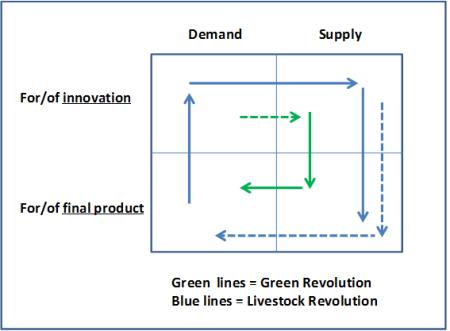This distinction between a supply (Green) and a demand (Livestock) driven agricultural revolution has often been repeated. It’s now inextricably linked to debates and discourse around the Livestock Revolution. However, to say that the Green Revolution was ‘supply driven’ is to suggest that an increased supply of wheat and rice, made possible in part by technological advances, preceded demand. Following this logic, the expanding supply then fuelled or drove increased demand for stable foods. This linkage is depicted by the solid green lines in the diagram below. But does it hold up to scrutiny?

During the decades prior to the Green Revolution, there was widespread and persistent hunger – and at times famine – in parts of Asia and elsewhere. In response, governments imported staple foods and there were large international movements of food aid. Poor, hungry people may not have had the ability to pay for the food they so badly needed, so from a standard economics perspective their hunger should not be seen as ‘unmet demand’.
On the other hand, it is right to say that the spectre of mass starvation was a significant part of the motivation to invest in the development and promotion of what came to be known as Green Revolution technology. From this perspective there was certainly demand (i.e. a willingness and ability to pay) for new, productivity increasing technology, and this demand fuelled the process that eventually led to increased supply. This linkage is the dashed green line on Figure 1.
This situation might be contrasted with one where agricultural researchers, off their own bats and without any prompting from policy makers, funders, farmers or industry, decided to develop e.g. new high yielding varieties. In this case any resulting change might rightly be described as ‘supply driven’.
Now we turn to the Livestock Revolution – the subject of a project recently begun by the STEPS Centre, focusing on poultry in Ghana. Here the implication of the label ‘demand driven’ is that demand precedes and fuels the supply response, where that response might depend on a combination of expanded capacity and technical / institutional innovation (this linkage is depicted by the solid blue lines on Figure 1). But again, is it that simple?
In fact, as acknowledged by Delgado et al., for dairy and poultry in the developed world, ‘technological progress arguably preceded and precipitated changes in demand through lower prices’ (p.59). Critically, much of this innovation – in genetics, equipment and feed formulations – has been transferred intact to the same developing country markets where the evidence for a Livestock Revolution is most compelling. This would indicate that for some of those products for which consumption is increasing most rapidly – like poultry meat – changes on the supply side may be much more important than indicated by the label ‘demand-driven’ (this linkage is depicted by the dashed blue lines in Figure 1).
The point is simple. When analysing the dynamics of major transformations in food and agriculture it is essential to ask: supply / demand of what (i.e. final product or innovation); and supply / demand by whom (i.e. policy makers, funder, consumers, industry players or producers)? Analysis along these lines may make it more difficult to claim uniqueness for the next food revolution, but it would provide a much better basis for comparative analysis.
Photo: Garissa cattle market from USAID’s photostream on Flickr
